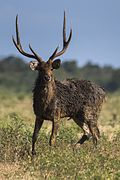Rusa (genus)
Appearance
| Rusa | |
|---|---|

| |
| Sambar | |
| Scientific classification | |
| Domain: | Eukaryota |
| Kingdom: | Animalia |
| Phylum: | Chordata |
| Class: | Mammalia |
| Order: | Artiodactyla |
| Family: | Cervidae |
| Subfamily: | Cervinae |
| Tribe: | Cervini |
| Genus: | Rusa C. H. Smith, 1827 |
| Type species | |
| Cervus unicolor | |
| Species | |
|
See text | |
Rusa is a genus of deer from southern Asia. They have traditionally been included in Cervus, and genetic evidence suggests this may be more appropriate than their present placement in a separate genus.[1]
Three of the four species have relatively small distributions in the Philippines and Indonesia, but the sambar is more widespread, ranging from India east and north to China and south to the Greater Sundas. All are threatened by habitat loss and hunting in their native ranges, but three of the species have also been introduced elsewhere.
The genus name derives from Malay rusa, meaning "deer."[2]
Species
[edit]| Image | Scientific name | Common name | Distribution |
|---|---|---|---|
 |
Rusa alfredi | Visayan spotted deer, Philippine spotted deer | The Philippines. |
 |
Rusa marianna | Philippine brown deer or Philippine sambar | Negros-Panay, Babuyan/Batanes, Palawan & the Sulu Faunal Regions, Philippines. |
 |
Rusa timorensis | Javan or Timor rusa, or Sunda sambar | East Timor; Indonesian islands of Flores, Gili Motang, Komodo and Rinca. |
 |
Rusa unicolor | Sambar, Indian sambar-deer, Malayan sambar | Most of the temperate, subtropical & tropical Indian subcontinent south of the Himalayas (incl. Bangladesh, Nepal, Sri Lanka), mainland Southeast Asia (incl. Cambodia, Laos, Malaysian mainland, Myanmar, edges of Singapore, Thailand, Vietnam), Brunei, Indonesia (Borneo, Sumatra), southern China (including Hainan Island) and Taiwan. |
References
[edit]- ^ Pitraa, Fickela, Meijaard, Groves (2004). Evolution and phylogeny of old world deer. Molecular Phylogenetics and Evolution 33: 880–895.
- ^ "Australian Deer Association". Australian Deer Association.
